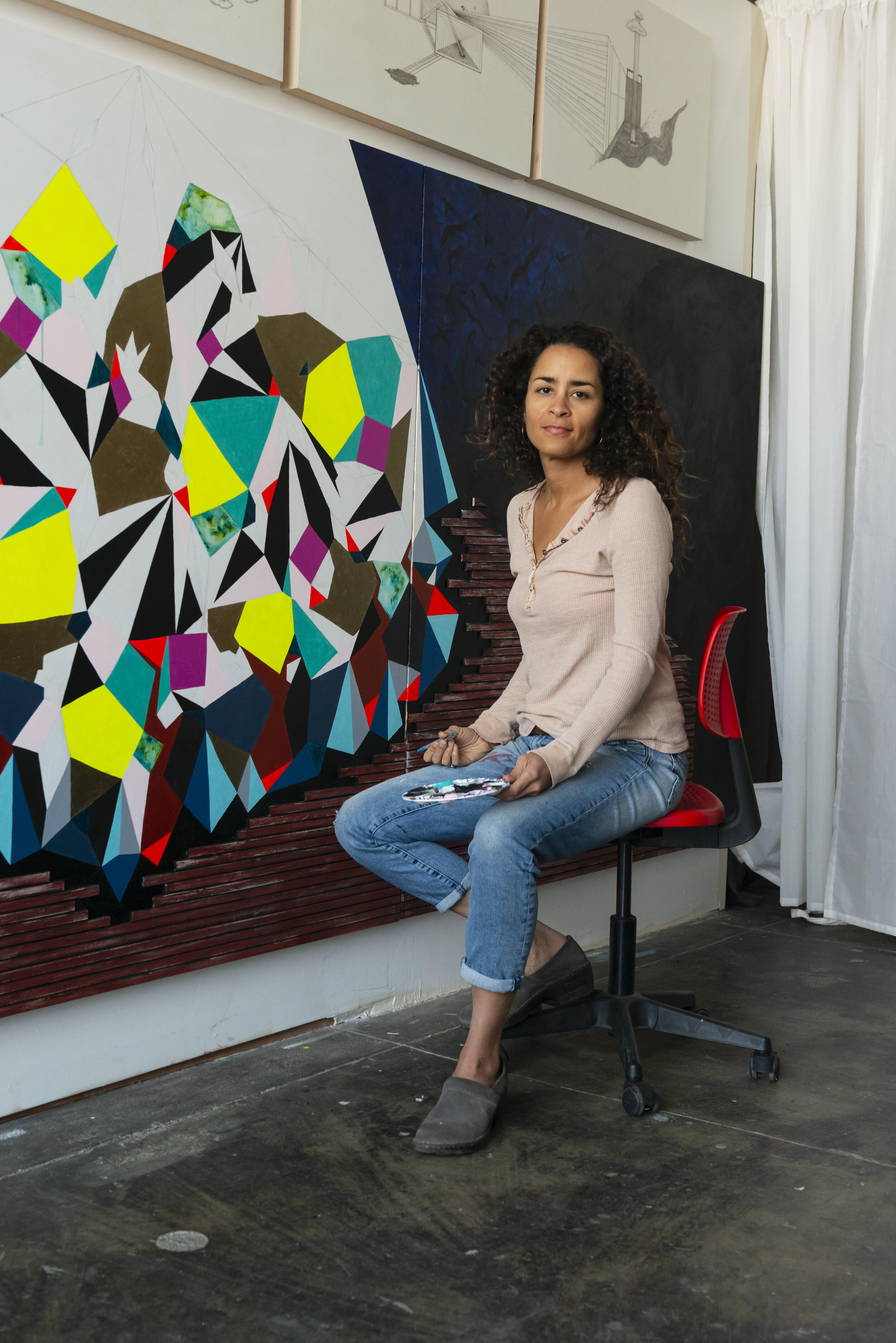Carlisle Berkley in Conversation with Artist, Adia Millett
After graduating from CalArts in 2000, Adia Millett moved to New York to join the Whitney Museum’s Independent Study Program in 2001. It was in the same year that her work was first featured in a group exhibition at the Studio Museum in Harlem, where she would go on to complete a residency. Her work is multidisciplinary and skillfully varied. In fact, her exhibition at California African American Museum ranged from sculpture to photography, collage, mural painting and textiles.
Adia Millett in her Oakland Studio
Millett’s recent exhibition at Morton Fine Art in Washington D.C., The Moon is Always Full included a series of pieces exploring how the moon acts as a metaphor for human subjectivity – paying particular interest to shadows. By focusing on the way that shadows give a disproportionate illusion of size and shape, Adia Millett explores the other ways that we think of shadows through perspective and light.
Her quilt and textile pieces cannot be located within just one cultural context. When deconstructing and layering found, gifted fabrics with Dutch Wax African textiles - a process of connectivity, taking things apart and connecting them to something else is central to her practice. Her textiles transform destruction into unity, new life and connection. Renewal and rebuilding create the possibility of transformative change. Her exploration of basic configuration reconstructs patterns and memories to achieve a sense of fullness for the viewer. This concept closely converses with how a shadow can create fullness within a figure – or the full cycle of a moon.
Sotheby’s Institute of Art student, Carlisle Berkley, interviewed Adia Millett to discuss her quilting, the moon and other inspirations behind her work.
Carlisle Berkley: Could you please give MADE IN BED readers some insight into your background and tell us how you became interested in the arts, particularly the medium of textiles and quilting?
Do you look to any other artists for inspiration such as the women working in Gee’s Bend, Alabama? If so, what about their work, in particular, inspires you?
Adia Millett: I am a big fan of the Gee’s Bend quilts. The colors, materials and form addressed issues of modernism before modernism even existed. Other textile artists who inspire me are Rosie Lee Tompkins and my mentor who taught me how to quilt, Roberta Andresen. With most textile and painting, it’s the artist’s use of color.
Adia Millett, Gold Moon (2020), 30.5 x 30.5 in., cotton, upholstery fabric and silk
CB: The works included in your exhibition The Moon is Always Full at Morton Fine Art frequently exhibit the moon. What interests you about the moon?
AM: The moon acts as the perfect metaphor for so many aspects of life: seasons, cycles, change. The moon impacts the earth and its tides, which in turn impacts our marine life, et cetera. In this exhibition, I use the moon as a symbol for who you/we are. Here, even when the earth’s shadow stands between us and the light, we don’t become smaller. We remain full.
Installation view of Adia Millett’s The Moon is Always Full at Morton Fine Art from March 25- April 22, 2021. Photo Courtesy of Jarrett Hendrix.
CB: In many cultures, the moon deity is female-identifying and represents creativity and fertility, among other things. Do these associations resonate in your art?
AM: Humans love to put a gender on everything. I love and have been inspired by so many people and things that are identified as female. But at this point, I’m more interested in expanding rather than unpacking.
Adia Millett, Gold Roof (2019), 40 x 30 in., acrylic, gold leaf and plastic wood on panel
CB: I’m particularly interested in your use of materials in Gold Roof. Upon first look, the piece is a façade that almost confronts the viewer. But upon closer analysis, we see the realist windows that pierce through the façade and disrupt the confrontation. Can you talk a bit about the intention behind this piece?
AM: For me, Gold Roof is about our connection to our ancestors. My eye wants to focus on the ghost-like shapes amongst the bricks rather than the layers of gold leaf. The cut-out windows and door help to also convey the painting of a house as a façade.
Installation view of Adia Millett’s OWF in The Moon is Always Full at Morton Fine Art. Photo Courtesy of Jarett Hendrix.
CB: In terms of color and shape, your piece OWF stands apart from other works in The Moon is Always Full – it’s also the only piece that doesn’t explicitly feature the moon, though its yellowish color reminds me of moonlight. Could you explain the title of the work to us and your inspiration behind the piece?
AM: OWF stands for Off White Fragility. This is a piece I did in 2019 for an exhibition entitled The Privilege to Breathe. I was thinking about the myriad of shades of white. It was my way of exploring the layers and complexity of our emotional fragility. As well as the ways in which “whiteness” is infused in so many things.
CB: Lastly, how do you know when you’re done with a piece?
AM: I don’t really know when something is finished. If I live with a piece long enough, I’m likely to change it, even years later. I usually just get to a point where I accept its imperfections enough to truly love it.
Adia Millett, Reflection (2020), 48 x 60 in., acrylic on wood







